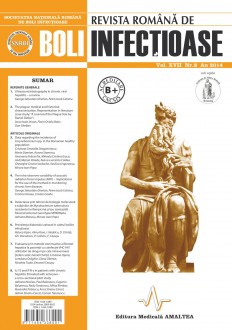SELECT ISSUE

Indexed

| |

|
|
|
| |
|
|
|

|
|
|
|
|
|
| |
|
|
HIGHLIGHTS
National Awards “Science and Research”
NEW! RJID has announced the annually National Award for "Science and Research" for the best scientific articles published throughout the year in the official journal.
Read the Recommendations for the Conduct, Reporting, Editing, and Publication of Scholarly work in Medical Journals.
The published medical research literature is a global public good. Medical journal editors have a social responsibility to promote global health by publishing, whenever possible, research that furthers health worldwide.
DATA REGARDING THE INCIDENCE OF CORYNEBACTERIUM SPP. IN THE ROMANIAN HEALTHY POPULATION
Cristiana Cerasella Dragomirescu, Maria Damian, Aurora Stănescu, Anamaria Felicia Ilie, Mihaela Cristina Giuca, Andi Marian Palade, Ileana-Luminita Coldea, Gheorghe Cristian Iordache, Vasilica Ungureanu and Mircea Ioan Popa
ABSTRACT
Although controlled by vaccination long ago, diphtheria may become a re-emergent disease as a result of at least two factors: the circulation of toxigenic strains in endemic areas (countries of former CSI, some of them neighbouring countries of Romania) and the lack of interest of the local health institutions for surveillance of this very low incidence disease. The aim of this study was to evaluate the carriage of potentially toxigenic Corynebacterium strains in healthy people in Romania. In this study, 1120 biological samples were analysed consisting of swabs, nasal exudates and conjunctival secretions collected from 730 healthy individuals from eight different geographic regions of the country, in order to establish carriage of potentially toxigenic strains belonging to the Corynebacterium genus. 129 strains of the Corynebacterium species were isolated and identified by phenotypic and molecular methods: Corynebacterium pseudodiphtheriticum (n = 76), C. propinquum (n = 34), C. striatum (n = 9), C. macginleyi (n = 2), C. glucuronolyticum/seminale (n = 2), C. group F1(n = 6). These species are saprophytic species for the upper respiratory tract, some of them being an opportunistic pathogen especially in immunocompromised hosts. The present data require the attention of clinicians, epidemiologists and microbiologists since diphtheria is an infectious disease that could re-emerge.
Keywords: Corynebacterium spp., diphtheria, corynebacteria healthy carriers
